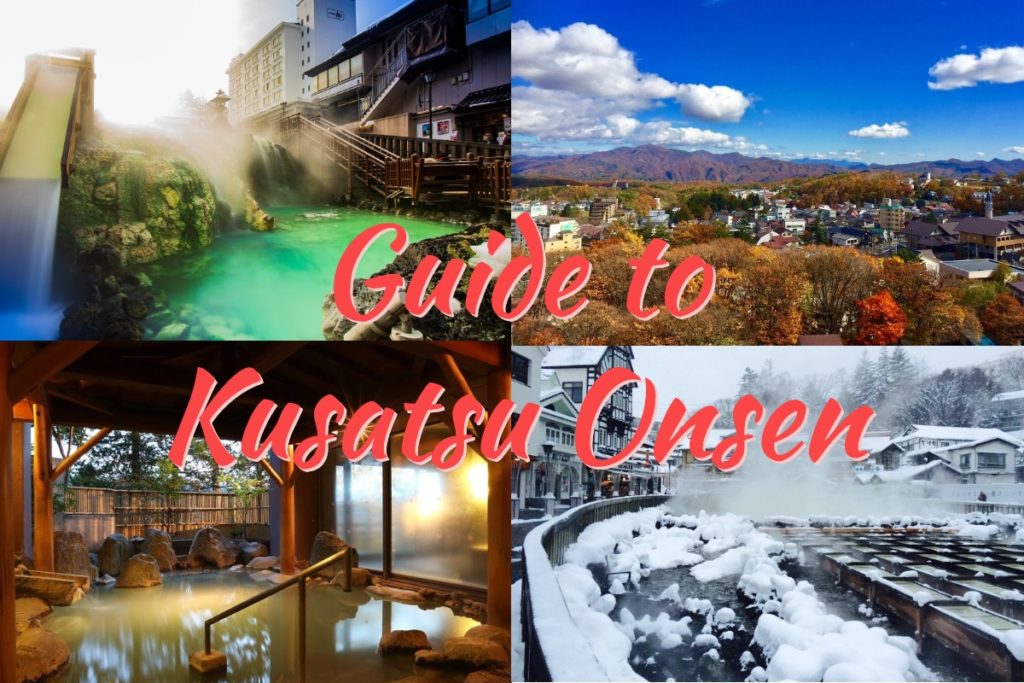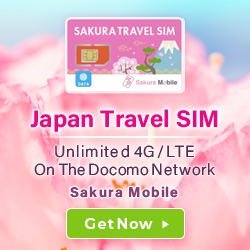Photos courtesy of Nguyen TP Hai on Unsplash (top left) and Kusatsu Onsen Hotel Sakurai
Kusatsu Onsen is one of the three most famous hot springs in Japan and is a popular spot frequented by both locals and international travelers. To help first-time visitors to Japan enjoy Kusatsu Onsen 120% more, the Sakura Mobile Blog Team has created a complete guide to Kusatsu Onsen.
As a member of the Sakura Mobile Blog Team who has visited Kusatsu myself, I will also be including small comments about my own experiences.
In this article, you will learn about the best places to stay, things to do at Kusatsu Onsen, recommended food and where to get it, and the best spots to visit.
We hope you find this guide useful!
Have you booked your SIM card or pocket WiFi for your trip to Japan yet?
In Japan, you’ll want to be connected without missing out on high speed data and internet!
By reserving online before departing, you can
- Lower your rental fees
- Avoid stock shortages at the airport
To learn more about data and WiFi options for your trip, check out our products below.

Hello readers! Sakura Mobile is a SIM & WiFi service provider for international residents and tourists in Japan.
Our global editorial team living in Japan will introduce the charms of the country based on what we have actually experienced and felt.
Table of contents
- What kind of place is Kusatsu Onsen?
- How to enjoy Kusatsu Onsen
- Ryokan and hotels at Kusatsu Onsen
- Things to do – Culture & nature
- Things to do – Adventure & fun
- Food and restaurants in Kusatsu Onsen
- Example of a two-day, one-night travel plan
- When to visit Kusatsu Onsen
- How to get to Kusatsu Onsen
- Kusatsu Onsen map
- Things to keep in mind
- Conclusion
1. What kind of place is Kusatsu Onsen?
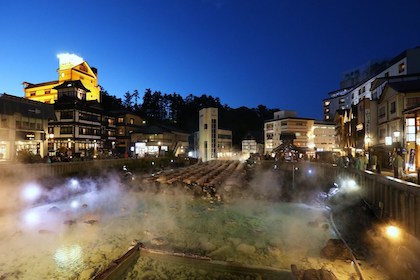
Kusatsu Onsen is a famous onsen town located in Gunma Prefecture. More than one million people visit Kusatsu onsen every year and it has been popular since the Meiji era (1868 – 1912).
Located in between Mt. Shirane and Mt. Motoshirane, Kusatsu Onsen was discovered more than 1800 years ago. For many years after its discovery, only nobles were allowed to enter Kusatsu; however, after the Meiji period, it opened to the public.
Boasting the largest amount of natural water flowing from its springs in all of Japan, the water of Kusatsu is highly acidic and rich in minerals. The water is known to have healing properties against almost any ailment and has relieved people of joint, muscle, and skin-related issues.
↑ Go back to the table of contents
2. How to enjoy Kusatsu Onsen
Known for its rich history, Kusatsu Onsen retains traditional Japanese culture through its onsen, food, clothes, etc. The inns and restaurants that have been operating for many years keep generations of Japanese families coming back to the onsen town.
Walk around the Yubatake
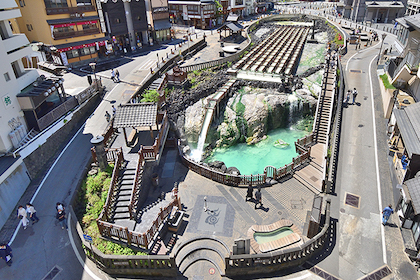
Located in the center of Kusatsu Onsen, the “Yubatake” is the main attraction and the place where the natural hot spring water is produced. Yubatake translates to “Hot Water Field”.
Around the Yubatake there are many restaurants where you can enjoy eating traditional Japanese food and sweets. You will see many people around wearing yukata (informal traditional Japanese dress). These yukata may look much like robes, but it is very normal for guests to walk around the Yubatake and explore the town in them. At night, the Yubatake is lit up, making it a great spot to get some pictures.
Dip your feet in an ashiyu
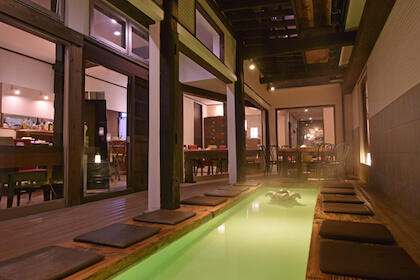
Even without having to spend the night at a ryokan that pulls water from the Yubatake, there are multiple ways to enjoy the hot springs at Kusatsu, one of which being an “ashiyu.” An ashiyu is a bath for just your feet. You can find them while just walking around the Yubatake.
If you’ve been exploring Kusatsu and your feet are aching, it might be a good idea to stop and take a break to enjoy the ashiyu.
At Kusatsu, you can even find an “ashiyu cafe” where you can dip your feet in the water while enjoying a snack or a drink.
Take in the surrounding nature
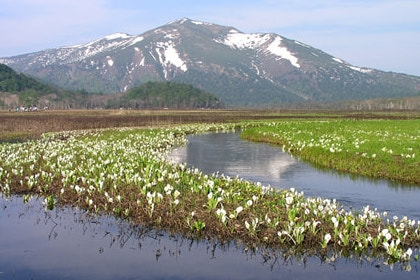
The remains of volcanic eruptions have made many rocks and lakes in the Kusatsu area that are loved by nature photographers. Mt. Shirane is a popular tourist location for its visitors to look upon the magnificence of Kusatsu Onsen. You can enjoy the ever-changing color of the leaves and bask in the wonderful fragrances from the various flowers blooming.
We will introduce some of the best nature spots Kusatsu has to offer later in this article.
↑ Go back to the table of contents
3. Ryokan and hotels at Kusatsu Onsen
Here are four recommended ryokan and hotels at Kusatsu Onsen.
Kusatsu Onsen Hotel Sakurai (草津温泉ホテル櫻井)
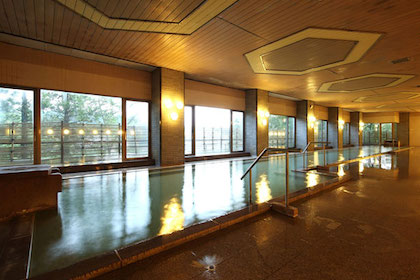
Just a nine-minute walk from the Yubatake, Kusatsu Onsen Hotel Sakurai is one of the best places to experience the hot springs in Kusatsu. There is no extra water added, meaning that you can experience the all-natural onsen. The public bath area is one of the largest, at a length of 30 meters. Unlike other hotels, the time that the bath is cleaned is in the morning and early afternoon so you can use the public bathing area even late at night.
There are multiple options for room size, and both Japanese-style and Western-style are available. For those looking for a taste of luxury, we recommend staying in the guest suite with an outdoor bath attached.
Information
- Price: Starting from around 14,300 JPY per person/night
- Address: 465-4 Kusatsu, Agatsuma District, Gunma 377-1711 (Google MAP)
- # of Rooms: 173
- Large Public Bath: Available
- Private Rental Bath: Not available (You can rent a suite with a private bath)
- Visit Official Site
Kusatsu Onsen Hotel Village (草津温泉ホテルヴィレッジ)
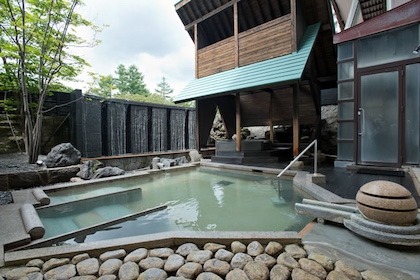
Kusatsu Onsen Hotel Village provides visitors with a relaxing Japanese-style getaway amidst the lush forest of Kusatsu. Note that this hotel is a ways from the main area of Kusatsu Onsen, but you can ride a free shuttle bus that will take you into town.
Along with having three different types of hot spring water and many types of baths in the public bathing area, you can pay a separate fee (2,640 JPY) to experience a special spa-like relaxation course not available anywhere else.
Information
- Price: Starting from around 9,900 JPY per person/night
- Address: 618 Kusatsu, Agatsuma District, Gunma 377-1711 (Google MAP)
- # of Rooms: 162
- Large Public Bath: Available
- Private Rental Bath: Available
- Visit Official Site
Yuyado Tokinoniwa (湯宿 季の庭)
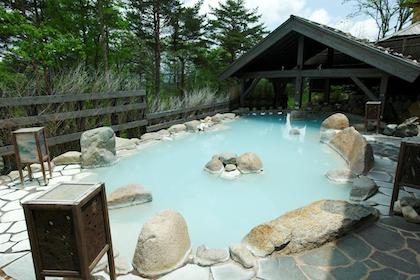
Located a six-minute car ride (or a 15-minute walk) from the Yubatake, Yuyado Tokinoniwa is a ryokan that aims to provide its guests with a luxurious stay in traditional Japanese hospitable style. There are a grand total of 23 different types of baths all in the public bathing area, and even a rentable bath is available if you are interested in having the hot springs all to yourself.
The food at this ryokan is all traditional Japanese food, recommended for those who want to get a fully immersive experience. All the rooms are also Japanese-style with an outdoor bath attached, making this one of the more high-class ryokan on our list.
Information
- Price: Starting from around 22,000 JPY per person/night
- Address: Shirane 464−214, Kusatsu, Agatsuma District, Gunma 377-1711 (Google MAP)
- # of Rooms: 64
- Large Public Bath: Available
- Private Rental Bath: Available
- Visit Official Site
Kusatsu Onsen Naraya (草津温泉 奈良屋)
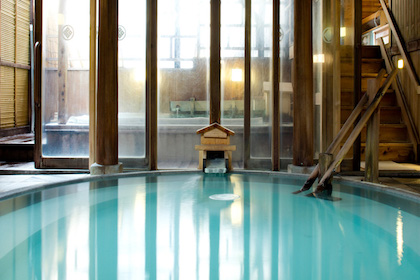
Kusatsu Onsen Naraya is a traditional Japanese ryokan that has been in operation since 1877. It is located right next to the Yubatake in the center of town, making it the most conveniently located lodge on our list. The hot spring water used is some of the oldest in Kusatsu. There are also rentable private onsen available for a separate fee, which is an option often used by families.
The rooms are a mix of Japanese and Western architecture and are named after various Japanese flowers. All the suites are very spacious, allowing parties of all different sizes a relaxing stay.
Information
- Price: Starting from around 26,950 JPY per person/night
- Address: 396 Kusatsu, Agatsuma District, Gunma 377-1711 (Google MAP)
- # of Rooms: 36
- Large Public Bath: Available
- Private Rental Bath: Available
- Visit Official Site
↑ Go back to the table of contents
4. Things to do – Culture & nature
Kusatsu an old town located in the mountains of Gunma prefecture, making it the perfect location to experience Japanese tradition. The following are spots that we recommend to both first-time visitors and experienced onsen-goers alike.
Yumomi Show (湯もみと踊りショー)
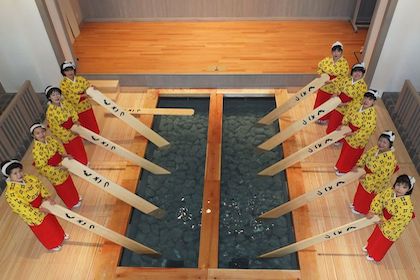
“Yumomi” is a process that started thousands of years ago to cool the hot spring water down before bathing in it. The process involves using large wooden paddles to move around the water. It would be easiest to put cold water into the onsen, but Yumomi is done to keep the water 100% natural.
In the Edo Period, people would participate in what was called “Jikan-yu,” which translates simply to “hot water time.” This is when people would all enter the bath at the same time after the Yumomi had taken place. You can still experience this today (it has even been proven to have positive health effects), but beware that bathing in scalding hot water is not for everyone and can be very painful.
Even without participating in Jikan-yu, you can still watch the Yumomi Show, which will give you a taste of pre-modern Japanese culture. This is a popular tourist spot and brings in hundreds of people every day.
Information
- Price: 600 JPY/person
- Hours of Operation: 9:30 am – 4:30 pm
- Visit Official Site
Sainokawara Park (西の河原公園)
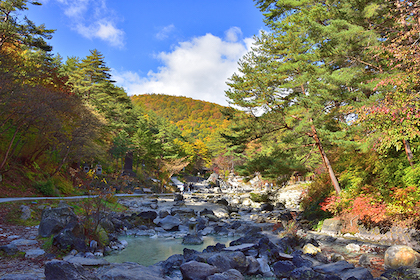
Sainokawara Park is located to the west of Kusatsu Onsen. It is accessible by foot so you will not need a car. Most visitors to Sainokawara Park are looking to enter the outdoor bathing area. It is a grand 500 square meters in area, separated down the middle by gender.
You will be able to bathe in one of the two spacious areas surrounded by the forest. The bath is especially beautiful in the fall and winter; the fall for its colorful leaves and the winter for its snowscapes.
At night, both the bathing area and the surrounding park is lit up, giving it a romantic feel. In the park area, you can find a shrine and a scenic riverbank. If you are traveling to Kusatsu with your partner, Sainokawara Park should be on your itinerary.
Information
- Price: 600 JPY/person
- Hours of Operation: 7:00 am – 8:00 pm (9:00 am – 8:00 pm in the winter months)
- Visit Official Site
Shirane Shrine (白根神社)
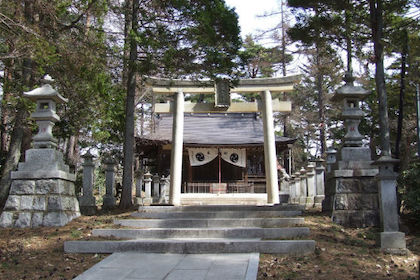
Shirane Shrine is located slightly north of the Yuabatake at the top of a long staircase of stone steps. Although close to the center of the onsen town, Shirane Shrine is a quiet place and can provide you with a good resting place if you need a break from the more crowded areas of Kusatsu Onsen.
Especially pretty in the fall with the changing leaves, Shirane Shrine is a location that is rich with Kusatsu’s history and is definitely worth visiting if you are a fan of traditional Japanese shrines and temples.
Yoshigadaira Wetlands (芳ヶ平湿原)
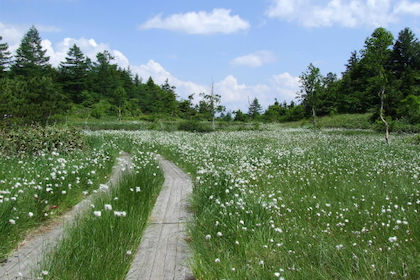
The Yoshigadaira Wetlands are on this list especially for those who are looking to spend time in the great outdoors. The area was created due to the volcanic activity of the nearby Mt. Kusatsu-Shirane. People visit year-round to gaze down at the everchanging scenery of the wetlands. You can see fields of green in the springtime and in the summer cotton grass dots the area.
The Yoshigadaira Wetlands feature marshes, rivers, and swamps. It also has trails, making it popular among hikers.
↑ Go back to the table of contents
5. Things to do – Adventure & fun
Even though Kusatsu is a small town and is far from what one would consider a city, there are still many fun activities to do in the area. The following are some establishments that will get you outside and moving around.
Kusatsu Onsen Ski Resort (草津温泉スキー場)
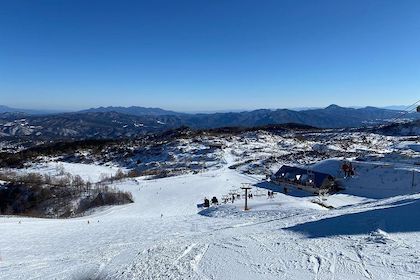
Although Kusatsu is known mostly for its onsen, Kusatsu Onsen Ski Resort is an expansive facility that caters to skiers in the winter. You might find that Kusatsu is a bit less crowded compared to the most popular skiing areas of Japan, making it a good choice for beginners.
For those who have never skied before, Kusatsu Onsen Ski Resort offers a package for those who do not have any ski equipment or experience. If you are staying multiple nights at the resort, you can get a discount on your rentals as well.
Outside of ski season, you can still visit Kusatsu Onsen Ski Resort and have a great time. During what is called “green season,” Kusatsu Onsen Ski Resort features activities especially to be done outdoors that do not involve any snow.
Information
- Price: 3,000 JPY/person (2,000 JPY for children)
- Hours of Operation: 8:30 am – 4:30 pm
- Visit Official Site
Tenguyama Play Zone (天狗山プレイゾーン)
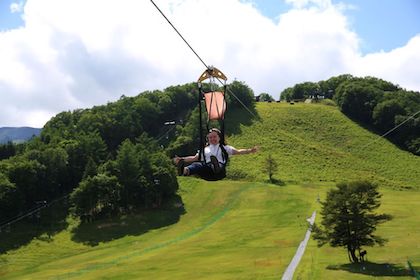
Tenguyama Play Zone is located within the Kusatsu Onsen Ski Resort, but it is large and there are so many things to do, we believe that it needed its own section. With a multitude of activities such as grass skiing, trampolines, and multiple golf courses, Tenguyama Play Zone is fun for the whole family. It is a perfect way to enjoy the warm months of the year while getting physically active.
Possibly one of the most fun activities to do at Tenguyama Play Zone is what is referred to as “BanZip TENGU.” It is a hybrid between a zipline and a bungee jump and will take you from the top to the bottom of the mountain in a harness. You can try out the BanZip TENGU at any time throughout the year.
Information
- Price: Free up to 5,000 JPY depending on the activity
- Hours of Operation: 9:00 am – 5:00 pm
- Visit Official Site
Kusatsu Tropical Wonderland (草津熱帯圏)
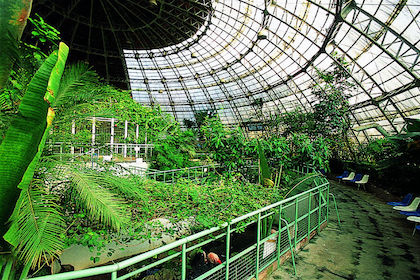
Kusatsu Tropical Wonderland is similar to a zoo but it features animals that come from tropical climates such as toucans, alligators, and more. It has the highest number of reptiles than any other zoo in Japan. Depending on the exhibit, you can even feed the animals. Kusatsu Tropical Wonderland also allows pets, making it easy to travel with your furry companions.
Kusatsu Tropical Wonderland operates all year round (even on the holidays), making it a perfect place to stop by, even if it was not originally on your itinerary.
Information
- Price: 1,100 JPY (800 JPY for high school students, 700 JPY for children)
- Hours of Operation: 8:30 am – 5:30 pm
- Visit Official Site
Kusatsu Forest Stage (草津フォレストステージ)
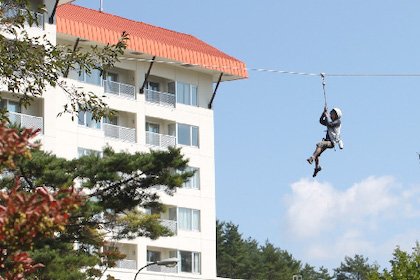
Kusatsu Forest Stage is a large-scale obstacle course, or “athletic” in Japanese. It will bring you through a series of challenges that will get you moving. Test your balancing, upper body strength, and other skills; you might just end up sore the next day.
Kusatsu Forest Stage has two different courses; one is for those who are looking for a fun exercise and the other is for those who are looking for a challenge. The “Master Course” has a total of 30 obstacles for you to try your hand at. Take note that there are some height and weight restrictions; if you are curious about the exact numbers, check out their official website.
Information
- Price: 3,850 JPY (2,860 JPY for elementary schoolers)
- Hours of Operation: Starts at 9:00 am, end time depends on the day
- Visit Official Site
↑ Go back to the table of contents
Have you booked your SIM card or pocket WiFi for your trip to Japan yet?
In Japan, you’ll want to be connected without missing out on high speed data and internet!
By reserving online before departing, you can
- Lower your rental fees
- Avoid stock shortages at the airport
To learn more about data and WiFi options for your trip, check out our products below.
6. Food and restaurants in Kusatsu Onsen
There are some foods that we believe that you should not miss out on while visiting Kusatsu. Here are our recommendations for specific food items and where to get them.
Onsen Manju
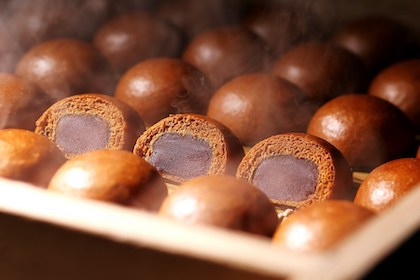
Manju are a type of traditional Japanese confection. They are steamed buns, usually filled with red bean paste. Manju tend to be small and very inexpensive, making them a good snack to carry around and eat. Onsen Manju are a type of manju that you can only find in onsen towns; some are even made using the onsen water.
When I visited Kusatsu, there were some shops sampling manju out on the streets. Definitely take advantage of this, especially if you are trying manju for the first time.
Yamabiko Onsen Manju is located only a two-minute walk away from the Yubatake, so it is the perfect spot to stop for a quick snack while you are walking around the center of town. The shop sells all kinds of manju, from the classic style to fried manju or manju made of sweet potato.
Information
- Name: Yamabiko Onsen Manju (山びこ温泉まんじゅう)
- Price: Starting at 100 JPY
- Hours of Operation: 9:00 am – 7:00 pm
Kamameshi
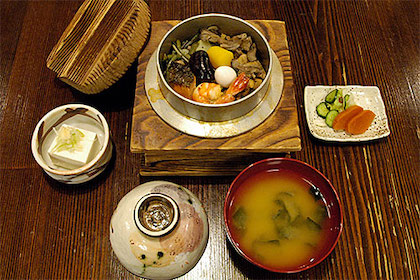
The word “kamameshi” refers to a Japanese rice-based dish cooked in an iron pot. Usually, the rice is flavored with mirin and other seasonings and is cooked with different vegetables and meats. People usually eat straight out of the pot.
Iiyama is a shop that sells kamameshi in Kusatsu. The restaurant closes once the kamameshi sells out, so make sure to get there early! Kusatsu is known for its maitake mushrooms, so we recommend that you get the maitake kamameshi (1,200 JPY) if you are lost on what to try.
Information
- Name: Iiyama-Tei (いいやま亭)
- Price: Starting at 980 JPY
- Hours of Operation: 11:00 am until the food runs out
- Visit Official Site
Soba
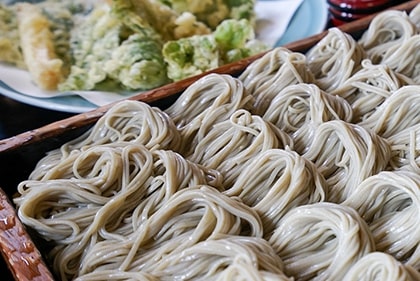
Kusatsu is known for its soba, a thin buckwheat noodle that is very different from other noodles that are popular in the west such as ramen. These noodles can be eaten either cold or hot.
Mikuni is a popular soba shop in Kusatsu that as a result, gets quite crowded. Mikuni is known for its portion sizes, as you can get a very large amount of noodles for a low price. You can also choose what kind of soup you want to go with your noodles. After your meal, be sure to try their traditional Japanese desserts as well that use red bean and mochi.
Information
- Name: Mikuni (三國家)
- Price: Starting at 800 JPY
- Hours of Operation: Lunchtime – 11:00 am to 2:45 pm; Dinner time – 5:30 pm to 9:30 pm (Closed on Tuesdays)
- Visit Official Site
↑ Go back to the table of contents
7. Example of a two-day, one-night travel plan
Here is a model course for a two-day, one-night visit to Kusatsu Onsen traveling from Tokyo. Feel free to refer to it when planning your own itinerary.
(Day 1)
8:00~
- Leave Tokyo and head to Gunma by train
- Take the shuttle bus up into the mountains to Kusatsu
11:00~
- Explore the town and take a look at the Yubatake
12:00~
- Have lunch at Iiyama-Tei
- Continue to explore town (maybe eat some manju if you’re still hungry)
14:00~
- Check out Shirane Shrine or Sainokawara Park
17:00~
- Check into your hotel or ryokan and get settled in
18:00~
- Eat a traditional Japanese dinner at the hotel
19:00~
- Go back into town and look at the lit-up Yubatake
- Have a few drinks and head back to your hotel
20:00~
- Use the public bathing area
- Relax in your room and go to bed
(Day 2)
8:00~
- Eat breakfast at your lodge or go into town to find something to eat
- Take a morning bath to get the most out of the onsen
10:00~
- Check out of your hotel
- Leave your luggage at the hotel to lighten the load you have to carry
12:00~
- Eat lunch at Soba Restaurant Aoyama
13:00~
- Visit Kusatsu Forest Stage
15:00~
- Visit Kusatsu Tropical Wonderland if you have time
18:00~
- Eat dinner in town and walk around a little more before getting on the bus
19:00~
- Head back to Tokyo
↑ Go back to the table of contents
8. When to visit Kusatsu Onsen
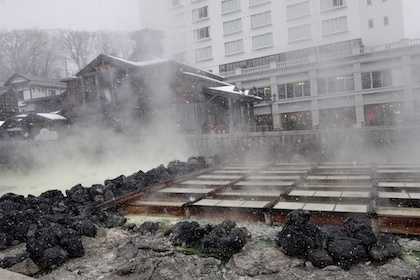
Because Kusatsu Onsen is most well-known for its hot springs, many people will visit during the summer or the winter. In the winter, there is snow and a large Christmas tree in the Yubatake area. In contrast, in the summer visitors can enjoy walking around town during the warm nights in yukata, which is the peak onsen experience.
I, personally, visited Kusatsu during the last days of the year in December. Even though it was not snowing in Tokyo at the time, Kusatsu’s streets and buildings were covered with it. Although crowded because of the holiday season and freezing cold, getting to see the snow was great.
The Yubatake is especially a special sight during the winter nights when it is lit up. You can see in the picture above how the steam from the Yubatake fills the air; the darkness at nighttime makes it feel as if you are walking through a sea of fog.
Although summer and winter are the most popular seasons (as well as the most crowded), this does not by any means imply that Kusatsu Onsen is not a good vacation spot during other times of the year. With the abundance of the surrounding greenery, you can expect to see the leaves changing color in the fall or flowers blooming in the spring.
Additionally, if you happen to be in town at the right time, you can sometimes see a fireworks show in the spring. This is quite unusual for Japan which usually features fireworks in the summer.
↑ Go back to the table of contents
9. How to get to Kusatsu Onsen
Traveling from Tokyo
There are multiple options for those traveling to Kusatsu from Tokyo. From Ueno Station, you can take an express train that travels straight to Kusatsu. From there, you need to ride a bus that will take you to the onsen town. The whole journey will take about three hours and will cost a little over 5,000 JPY. Alternatively, you could take a normal train that is around one hour longer but will save you around 2,000 JPY.
For those who are not familiar with trains and want to go directly to the onsen town, there is a bus that departs from various stations in Tokyo that travels to Kusatsu. This will also take about 3 to 4 hours and will cost you around 3,500 JPY depending on the season.
Traveling from Kyoto or Osaka
Kusatsu is located north of Tokyo, making it a bit of a journey for those traveling from the west side of Japan. A series of buses is the most cost-effective option at a total of 6,000 JPY one way during the cheapest seasons. However, the entire journey will take you over 10 hours and is not recommended for those who are tight on time or have difficulty sleeping on buses.
If you are willing to spend some more money and want to save time, we recommend taking the bullet train and then a bus to the onsen town. It will cost around 20,000 JPY and will take around 5 hours.
↑ Go back to the table of contents
10. Kusatsu Onsen map
Below is a map that features the main sightseeing spots, the lodges, and restaurants that were mentioned in this article.
↑ Go back to the table of contents
11. Things to keep in mind
Do you have tattoos?
Although the attitude towards tattoos is slowly changing in Japan, many hotels and ryokan still do not allow guests with tattoos to use the public baths. Instead, we recommend that those with tattoos rent a guest suite with a private onsen attached or rent a private bath.
The hotels and ryokan that were mentioned in this article all allow guests with tattoos to use the private onsen.
Types of onsen
Because Kusatsu Onsen is known for the hot springs in particular, you will be able to find all sorts of establishments where you can try out the onsen. Even if you are not staying at a hotel or ryokan with a particularly luxurious bath, many places in town will let you bathe in a public onsen for a small fee.
There are also many “ashiyu,” onsen just to dip your feet in, around town so make sure to take advantage of those as well. You can consult the staff of your hotel or a tourist information center for more details on the locations of these other onsen establishments.
Onsen etiquette
To protect the onsen there are certain etiquettes you need to follow before, during, and after dipping in the onsen. These rules are more strict than you might think, and sometimes even Japanese natives have trouble knowing exactly what to do.
The Japan Spa Association has a guide you can follow.
Ryokan etiquette
There are simple etiquettes you need to follow while at your stay at Kusatsu Onsen. The Kusatsu Tourists Association has a guide you can follow.
Food allergies
Restaurants and hotels in Kusatsu can cater to customers who have food allergies or dietary restrictions. Some hotels, ryokan, and even some restaurants also provide vegetarian or vegan dishes.
Food allergies are generally less prevalent in Japan, so be sure to ask someone who works at the restaurant if you are worried. If you have other dietary restrictions and are staying at a ryokan that serves you breakfast and dinner, make sure to call and ask beforehand about your options.
Bring cash
Because Kusatsu is still quite old-fashioned and is a small onsen town, most traditional restaurants and shops will not take card. However, you will find that the more modern-looking buildings and souvenir shops tend to take card or other forms of cashless payment.
To be safe, we recommend keeping enough cash on you while traveling.
Foreign currency exchange machines
Foreign currency can be exchanged at Gunma Bank (Kusatsu branch) and the bank is open from Monday to Friday from 9:00 am to 3:00 pm. However, Tokyo and other big cities have a larger abundance of options for exchanging currency. Therefore, we recommend you exchange any currency you may want to spend in Kusatsu before making the trip.
Is there Internet access?
Although it does not compare to inner-city areas like Tokyo, Kusatsu has quite a few places where you can find free WiFi. Most hotels and gift shops have FREESPOT WiFi access points to make sure you are connected during your trip.
English-speaking tourist information center
Most tourist locations in Kusatsu Onsen have information centers with people who can speak English. The information centers will often have pamphlets and maps to guide you on your journey to the best places in Kusatsu. You can find more information on these establishments here.
↑ Go back to the table of contents
12. Conclusion
What did you think?
Kusatsu is an extremely popular vacation spot and one of the most highly recommended onsen towns if you are visiting Japan. It boasts a rich history as well as nature, allowing you to experience a vacation in what feels like traditional Japan.
With easy access from Tokyo and high-quality hot spring waters, we believe that Kusatsu should be high on your list if you want to visit an onsen town. Providing a quiet getaway in the mountains, Kusatsu is the perfect area to explore with your friends, family, or partner.
Have fun on your trip!
Have you booked your SIM card or pocket WiFi for your trip to Japan yet?
In Japan, you’ll want to be connected without missing out on high speed data and internet!
By reserving online before departing, you can
- Lower your rental fees
- Avoid stock shortages at the airport
To learn more about data and WiFi options for your trip, check out our products below.

